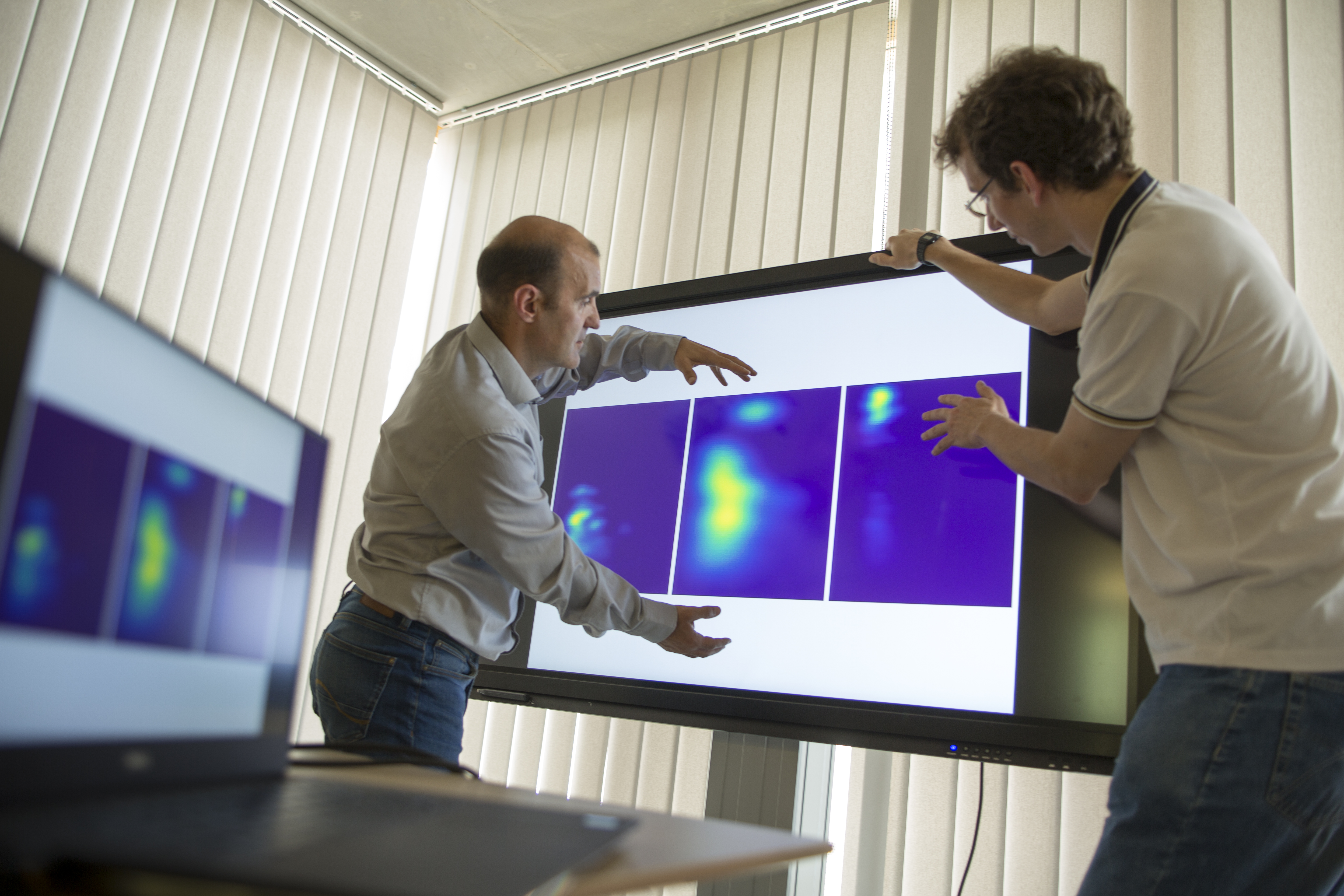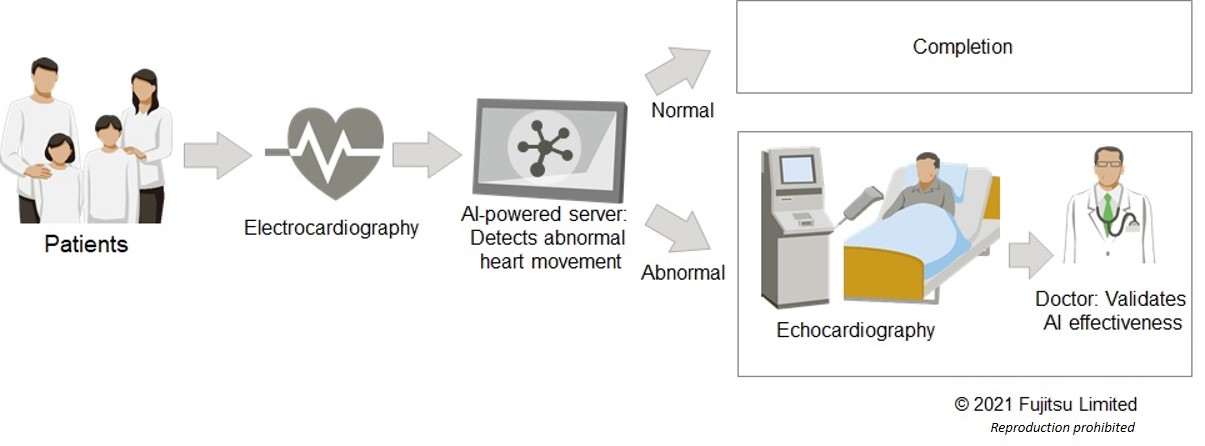
Harnessing AI to prevent heart disease
Heart disease is the leading cause of death worldwide and the second leading cause of death in Japan. Electrocardiography is widely used to detect abnormalities in the heart muscle and irregular pulses, but is difficult to use to diagnose conditions linked to the shape and movement of the heart. For this, doctors use echocardiography, an examination that must be performed in specialized facilities and that may not be available to all patients, making early detection more difficult.
In October, Fujitsu and the University of Tokyo Hospital began a clinical trial that aims to evaluate the effectiveness of artificial intelligence in early detection of heart disease based on data from electrocardiograms. The trial uses AI technology developed by Fujitsu and Inria to detect anomalies in time-series data thanks to a waveform analysis technology based on Topological Data Analysis (TDA). The AI will be used to identify the presence or absence of abnormal heart movements in patients undergoing electrocardiograms at the University of Tokyo Hospital. In patients where the AI detects abnormalities, a doctor will perform an echocardiography and the results predicted by the AI will be compared to the medical diagnosis.
A healthy partnership
This preventive health application has been made possible by the research partnership between Fujitsu and DataShape project-team (Inria – Laboratoire de Mathématiques d’Orsay, Université Paris-Saclay) that began in 2017, as part of a multi-million euro investment plan by the Japanese group to support digital innovation in France. “We saw strong potential in France for partnerships that could enhance both our research and our business in digital,” says Yuzuru Yamakage, Head of AI Services Department at Fujitsu Limited. “DataShape’s promising results in developing AI tools made them an ideal partner.”
The complementarity of the two sides in the partnership also makes it highly constructive for Inria. “It has been one of our most effective collaborations so far,” says Frédéric Chazal, DataShape Project Team Leader at Inria. “We work as a very close-knit team with Fujitsu’s engineers and researchers. They provide motivating industrial problems, while we provide the academic knowhow and we work on the science together.”
Reaching out to the AI community
The success of the Fujitsu-Inria research partnership can also be measured in terms of publications. Their work has been presented at major conferences on machine learning in AI, such as IJCAI, AISTATS or the 2021 ICML conference, where their paper was selected for oral presentation. And dedicated workshops were held at the 2020 NeurIPS conference.
“We aim to produce a small number of high-quality papers and to have them published in the best conferences and journals,” says Frédéric Chazal. “With the support of Fujitsu, my team is also developing the GUDHI open source software library which makes our work available to the whole AI community.” “It may seem unusual for a corporation to support this kind of initiative,” adds Yuzuru Yamakage, “but we want to encourage TDA to develop more widely, and restricting access to our knowledge to our own engineers would not support the wider AI community. More interest in TDA will ultimately mean more business opportunities for Fujitsu.”
Tracking time-series data
Their joint research programme focuses on developing TDA analysis methods for a range of AI applications, including healthcare.
Verbatim
Our technology uses TDA to extract the different features that are hidden in the time-series data and converts them into a figure, mapping them on a chart.
Head of AI Services Department at Fujitsu Limited
In March 2020, they announced that they had jointly developed novel technology that automatically creates AI models capable of detecting anomalies in time-series data. This includes sensor data from IoT devices or biological data and consists of information on a wide range of types with complicated interconnections. Some features appear over short time periods, and some over long time periods, and there may also be features such as frequency and amplitude. Time-series data is therefore often subject to high volatility, making it difficult to discern meaningful patterns or anomalies.
“Our technology uses TDA to extract the different features that are hidden in the time-series data and converts them into a figure, mapping them on a chart showing the length of the time period and the features of the behaviour of the waveform over that period,” explains Yuzuru Yamakage. “This clear representation makes it simpler and faster for users with limited expertise to analyse and identify any anomalies.”
Preventive applications
Before being applied in the clinical trial at the University of Tokyo Hospital trial, the technology has been tested in several fields. In AI empowered infrastructure maintenance, the team used their algorithm to analyse inspection data from sensors on bridges and were able to detect internal damage and predict where and when engineers needed to carry out preventive repairs.
Verbatim
TDA is very robust to the different kinds of deformation in the data and therefore performs better when incorporating patients that haven’t previously been seen in the system.
DataShape Project Team Leader at Inria
They also investigated its effectiveness in accurately detecting arrhythmia, irregularities in heartbeat that may be a symptom of severe heart disease such as ventricular fibrillation. Here, TDA achieved much higher accuracy than other methods and reduced misclassification of the severity of the arrhythmia by 70%. “Most existing AI models are good at characterizing arrhythmia in people where the condition has already been observed, but poor in new patients,” says Frédéric Chazal, “but TDA is very robust to the different kinds of deformation in the data and therefore performs better when incorporating patients that haven’t previously been seen in the system.”
Promising early results
In December 2019, Fujitsu also began collaborating with the University of Tokyo Hospital on using the new TDA technology in electrocardiogram analysis. “We have been working with Dr. Katsuhito Fujiu of the Department of Cardiovascular Medicine to detect abnormal heart movement related to Left Ventricular Ejection Fraction1,” says Yoshimasa Kadooka, Principal Expert of DX Services Division at Fujitsu Limited. “Low LVEF can be a symptom of several serious heart conditions, making early detection vital.”
The team used TDA to develop an AI model to analyse around 630 000 pieces of electrocardiographic data, and data from some 140 000 echocardiographic examinations. The resulting high level of accuracy in detecting abnormal heart movements makes it a promising foundation for the clinical research now underway. If it confirms the initial findings, it will make a significant contribution to early detection of heart disease and prevention of progression to serious illness.
Verbatim
We have been working with Dr. Katsuhito Fujiu of the Department of Cardiovascular Medicine to detect abnormal heart movement related to Left Ventricular Ejection Fraction1.
Principal Expert of DX Services Division at Fujitsu Limited
“Based on the results of this clinical trial, we hope to promote research and development of a solution to detect abnormalities in heart movements at an early stage,” says Yoshimasa Kadooka. “Our joint research with Inria and with the University of Tokyo is an important part of Fujitsu’s efforts to leverage artificial intelligence in a range of preventive medicine applications, with the ultimate aim of improving the quality of life across society,” he concludes.
1. The percentage of the total left ventricular volume that can be delivered to the entire body by a single heartbeat.
